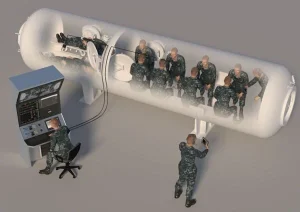 The new medical monitoring capability will enable continuous, real-time monitoring as soon as rescued submariners enter the deck decompression chamber. (JFD Global)
The new medical monitoring capability will enable continuous, real-time monitoring as soon as rescued submariners enter the deck decompression chamber. (JFD Global)United Kingdom-based marine engineering and services group JFD Global has begun development of an advanced medical monitoring system for introduction into the NATO Submarine Rescue System (NSRS).
Announcing the move on 30 September, the company said that the new system – combining wearable technology, diagnostics, and critical care tools – will expand monitoring capacity from four submariners up to 76, including medical personnel, during rescue operations. Implementation in the NSRS is planned for 2027.
According to JFD Global, which is currently contracted to support NSRS out to 2032, the new medical monitoring capability will enable continuous, real-time monitoring as soon as rescued submariners enter the deck decompression chamber on the rescue vessel. It adds that the system uses a three-tier approach: wearable devices to track key indicators such as heart rate, stress, fatigue, and core temperature; diagnostic tools including electro-cardiogram (ECG) monitors and ultrasound; and advanced critical care equipment for unstable or deteriorating casualties.
Data hubs, connected to more than 100 certified medical components, are designed to provide accurate and automated monitoring and can link via satellite for remote medical support. Making data instantly accessible to onboard medics and shore-based medical teams “enables faster response times, more accurate triage, and improved treatment outcomes in highly demanding clinical scenarios”, JFD said.
The company added that the same technology can be integrated across other submarine escape and rescue systems, or adapted for other defence and commercial diving operations. Complementary defence applications include submarine platforms, distressed submarine (DISSUB) entry kits, dive recompression chambers, and surface vessels.
